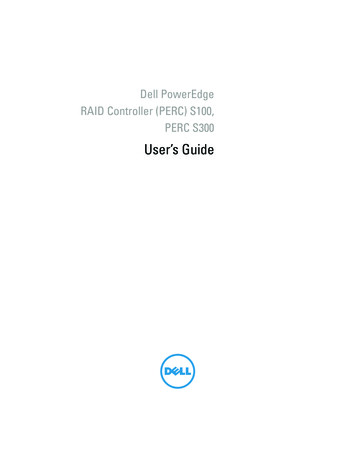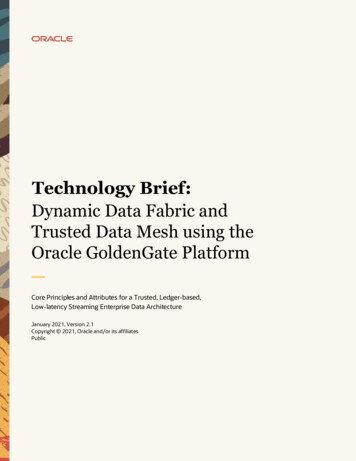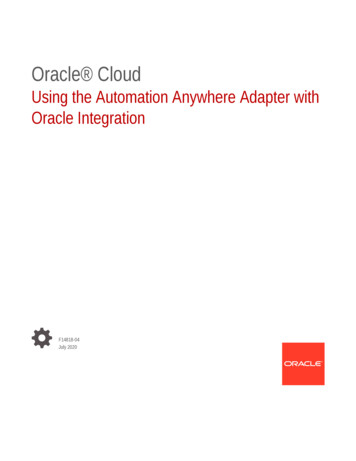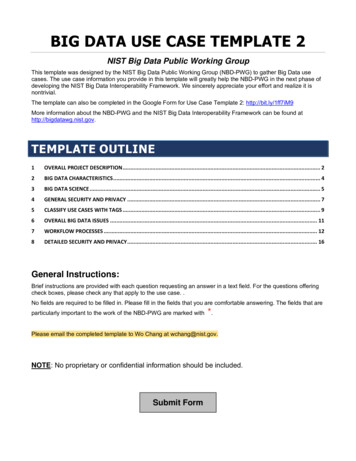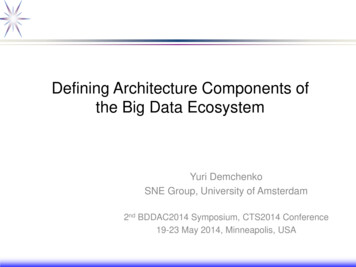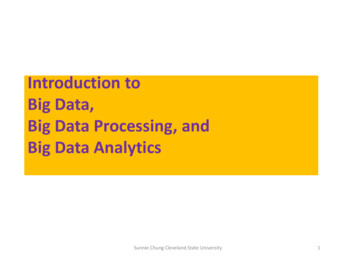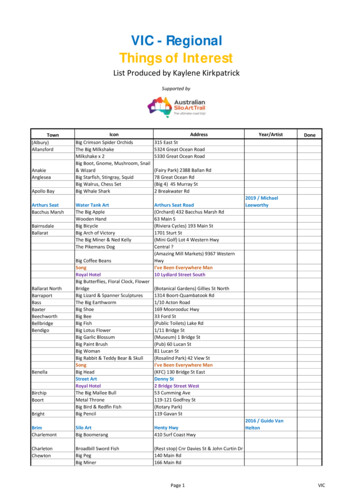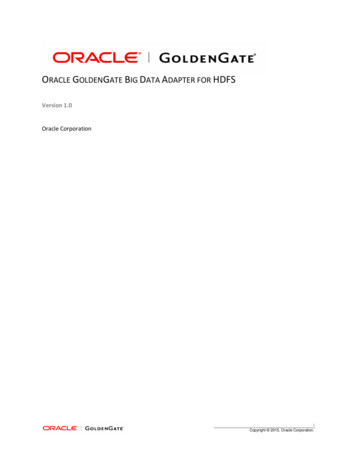
Transcription
ORACLE GOLDENGATE BIG DATA ADAPTER FOR HDFSVersion 1.0Oracle CorporationiCopyright 2015, Oracle Corporation.
Table of ContentsTABLE OF CONTENTS . 21.INTRODUCTION . 31.1 FUNCTIONALITY. 31.2 SUPPORTED OPERATIONS . 41.3 UNSUPPORTED OPERATIONS . 42.GETTING STARTED WITH THE HDFS ADAPTER . 52.1 RUNTIME PREREQUISITES . 52.2 ACCESSING THE PRECOMPILED HDFS ADAPTER . 52.3 BUILDING WITH MAVEN. 52.4 BUILDING WITH BUILD SCRIPT . 62.5 SAMPLE CONFIGURATION FILES . 62.6 CLASSPATH CONFIGURATION. 72.7 STARTING THE HDFS ADAPTER . 73.CONFIGURATION . 93.1 GG ADAPTER BOOT OPTIONS . 93.2 HDFS ADAPTER PROPERTIES . 94.PERFORMANCE CONSIDERATIONS . 114.1 GROUPING CONFIGURATION . 115.LIMITATIONS . 12This software and related documentation are provided under a license agreement containing restrictions on use and disclosure and are protected by intellectual property laws.Except as expressly permitted in your license agreement or allowed by law, you may not use, copy, reproduce, translate, broadcast, modify, license, transmit, distribute, exhibit,perform, publish, or display any part, in any form, or by any means. Reverse engineering, disassembly, or decompilation of this software, unless required by law forinteroperability, is prohibited.The information contained herein is subject to change without notice and is not warranted to be error-free. If you find any errors, please report them to us in writing.If this is software or related documentation that is delivered to the U.S. Government or anyone licensing it on behalf of the U.S. Government, then the following notice isapplicable:U.S. GOVERNMENT END USERS: Oracle programs, including any operating system, integrated software, any programs installed on the hardware, and/or documentation,delivered to U.S. Government end users are "commercial computer software" pursuant to the applicable Federal Acquisition Regulation and agency-specific supplementalregulations. As such, use, duplication, disclosure, modification, and adaptation of the programs, including any operating system, integrated software, any programs installed onthe hardware, and/or documentation, shall be subject to license terms and license restrictions applicable to the programs. No other rights are granted to the U.S. Government.This software or hardware is developed for general use in a variety of information management applications. It is not developed or intended for use in any inherently dangerousapplications, including applications that may create a risk of personal injury. If you use this software or hardware in dangerous applications, then you shall be responsible to takeall appropriate fail-safe, backup, redundancy, and other measures to ensure its safe use. Oracle Corporation and its affiliates disclaim any liability for any damages caused byuse of this software or hardware in dangerous applications.Oracle and Java are registered trademarks of Oracle and/or its affiliates. Other names may be trademarks of their respective owners.Intel and Intel Xeon are trademarks or registered trademarks of Intel Corporation. All SPARC trademarks are used under license and are trademarks or registered trademarks ofSPARC International, Inc. AMD, Opteron, the AMD logo, and the AMD Opteron logo are trademarks or registered trademarks of Advanced Micro Devices. UNIX is a registeredtrademark of The Open Group.This software or hardware and documentation may provide access to or information about content, products, and services from third parties. Oracle Corporation and its affiliatesare not responsible for and expressly disclaim all warranties of any kind with respect to third-party content, products, and services unless otherwise set forth in an applicableagreement between you and Oracle. Oracle Corporation and its affiliates will not be responsible for any loss, costs, or damag es incurred due to your access to or use of thirdparty content, products, or services, except as set forth in an applicable agreement between you and Oracle.iiCopyright 2015, Oracle Corporation.
1. INTRODUCTIONThe Oracle GoldenGate Big Data Adapter for HDFS is designed to stream change capture data intothe Hadoop Distributed File System (HDFS).The HDFS Adapter is designed to provide ready-made functionality, while at the same timemaintaining simplicity so that the source code is easily understood. Oracle GoldenGate customerscan use, modify, and extend the HDFS Adapter to fulfill their specific needs.The information in this document is not intended to replace the Oracle GoldenGate Java Adapterdocumentation. This document provides additional information specific to the HDFS Adapter.Customers unfamiliar with the Oracle GoldenGate Java Adapter should start by reviewing the OracleGoldenGate Java Adapter documentation.1.1 FunctionalityThe HDFS Adapter takes unfiltered operations from the source trail file and writes them to files inHDFS.Directory structure of filesThe HDFS Adapter writes to the HDFS directory configured by the user. The default HDFSdirectory is /ogg. The format of file names created in HDFS is the following: FILE PREFIX TIMESTAMP FILE SUFFIX The default file prefix is gg and the default file suffix is.txt. The timestamp is in the formatyyyy-MM-dd HH-mm-ss.SSS. Note: HDFS does not allow colons in file names. The prefix andthe suffix are optionally configurable by the user.Change data recordsData for each row operation is written to an HDFS file in the following format:First is the row metadata: SCHEMA NAME FIELD DELIMITER TABLE NAME FIELD DELIMITER OPERATIONTYPE FIELD DELIMITER TIMESTAMP FIELD DELIMITER Next is the row data: COLUMN 1 NAME FIELD DELIMITER COLUMN 1 VALUE FIELDDELIMITER . COLUMN N NAME FIELD DELIMITER COLUMN N VALUE LINEDELIMITER The column names can be configured to be omitted.iiiCopyright 2015, Oracle Corporation.
Data for different tables in the input trail file are interlaced in the output HDFS files. The HDFSAdapter begins writing a new file in HDFS when either of the following events occurs:1. The Oracle GoldenGate Extract process is started.2. The configured maximum HDFS file size is reached (default is 1 GB).1.2 Supported Operations InsertsUpdates including change to primary key(s)Deletes1.3 Unsupported Operations Truncate tableivCopyright 2015, Oracle Corporation.
2. GETTING STARTED WITH THE HDFS ADAPTER2.1 Runtime PrerequisitesIn order to successfully run the HDFS Adapter, a Hadoop single instance or Hadoop cluster must beinstalled, running, and network accessible from the machine running the Oracle GoldenGate HDFSAdapter. Apache Hadoop is open source and available for download at http://hadoop.apache.org/.Follow the Getting Started links for information on how to install a single-node cluster (also calledpseudo-distributed operation mode) or a clustered setup (also called fully-distributed operationmode).2.2 Accessing the Precompiled HDFS AdapterThe Oracle GoldenGate Big Data Adapter for HDFS installation includes the jar file for the OracleGoldenGate HDFS Adapter. The precompiled HDFS Adapter was built using version 2.5.1 of theHDFS client. The HDFS Adapter is available in the following location:GG ROOT s-adapter1.0.jarIf the above jar is being used instead of building the HDFS Adapter from source, then ogg-hdfsadapter-1.0.jar should be added to the gg.classpath variable in the properties file. Thegg.classpath variable must also include the HDFS dependency jars. This is generally resolved byaddingHDFS ROOT DIRECTORY/share/hadoop/common/lib/*:HDFS ROOT DIRECTORY/share/hadoop/common/* to the gg.classpath variable.2.3 Building with MavenThe Oracle GoldenGate Java Adapter 12 is built and runs with Java 7. It is required that the HDFSAdapter also be built with the Java SE Development Kit 7.The recommended method of building the Oracle GoldenGate HDFS Adapter is using Apache Maven.Maven is an open source build tool available for download at http://maven.apache.org. Maven iswell documented, rich in functionality, and widely used in the Java community. One of the biggestbenefits provided by Maven is that it will resolve and download the build and runtime dependenciesof the HDFS Adapter from the Maven central repository. Internet connectivity is required to accessthe Maven central repository. The HDFS example was built and tested with version 3.0.5 of Maven.The pom.xml file in the GG ROOT DIRECTORY/AdapterExamples/big-data/hdfsdirectory instructs Maven what version of the HDFS client to download and to build against. It isimportant that the HDFS client version match the version of HDFS to which it is connecting. UsingvCopyright 2015, Oracle Corporation.
mismatched versions of the HDFS client and HDFS server can result in serious problems. The versionof the HDFS client in the pom.xml file is 2.5.1. If using a version of HDFS other than 2.5.1 it is highlyrecommended that the user modify the pom.xml file so that HDFS Adapter is built against thecorrect version of the HDFS client, and the correct jar files are downloaded for use at runtime.WARNING: Many companies employ proxy servers to help protect their network from the hazardsof the Internet. Performing a Maven build while connected to the company network or VPN mayrequire that dependency downloads from the Maven central repository go through a proxy server.This may require special configuration of the Maven settings.xml file which is generally locatedin the USER HOME/.m2 directory. Consult your network administrator for proxy settings. Consultthe Maven documentation on how to correctly configure the settings.xml file for your requiredproxy settings.1. Navigate to the root build directoryGG ROOT DIRECTORY/AdapterExamples/big-data/hdfs2. Type the following command to build:mvn clean package3. Maven will download all the required dependencies and build the HDFS Adapter. The createdjar and the downloaded dependent jars will be placed in the following directory:GG ROOT s-lib4. One of the dependencies that Maven does not download is the Oracle GoldenGate Java adapter(ggjava.jar). This dependency is located in the following directory:GG ROOT DIRECTORY/ggjava/ggjava.jarThis dependency is instead resolved using a relative path inside the pom.xml file. If the HDFSAdapter project is copied to a different directory, the relative path to the ggjava.jar file willneed to be fixed by editing the pom.xml file.2.4 Building with Build ScriptA build script, build.sh, is provided in the GG ROOT DIRECTORY/AdapterExamples/bigdata/hdfs directory. This script is an alternative to the Maven build outlined above. The buildscript performs no downloads of the dependent jars. The build script assumes that HDFS is installedlocally and can resolve the build dependencies from the installation. The build requires that theuser set the HDFS HOME environment variable to the root HDFS installation directory. None of thedependent jars are copied using the build script. The build script simply builds and packages theHDFS adapter.2.5 Sample Configuration FilesSample configuration files for the Oracle GoldenGate Big Data Adapter for HDFS can be found at thefollowing locations:viCopyright 2015, Oracle Corporation.
The HDFS Extract process sample properties file is located at:GG ROOT s.prmThe HDFS Java adapter sample properties file is located at:GG ROOT s.propsThese files should be copied to the GG ROOT DIRECTORY/dirprm directory and renamed and ormodified as required.2.6 Classpath ConfigurationThe Oracle GoldenGate Big Data Adapter for HDFS obtains connectivity information to HDFS via theHadoop core-site.xml file. This file is generally located in the HADOOP HOME/etc/hadoopdirectory. The directory containing the properly configured core-site.xml file must beincluded in the classpath that is configured in the gg.classpath property in the HDFS Java adapterproperties file.The Oracle GoldenGate HDFS Adapter is dependent upon the HDFS client jars and all of itsdependencies. The easiest way to fulfill the runtime dependencies of the HDFS example is byconfiguring the gg.classpath configuration value in the Java properties file using the wildcardasterisk character (*). The GoldenGate Java properties file is very specific as to how the wildcardcharacter is used.The following works:gg.classpath GG ROOT slib/*The following does NOT work:gg.classpath GG ROOT slib/*.jar2.7 Starting the HDFS AdapterThe final step is to create and start the GoldenGate Extract process that invokes the HDFS Adapter.To create the Extract process from GGSCI:GGSCI ADD EXTRACT hdfs, EXTTRAILSOURCE dirdat/trail idTo start the Extract process:GGSCI START hdfsviiCopyright 2015, Oracle Corporation.
viiiCopyright 2015, Oracle Corporation.
3. Configuration3.1 GG Adapter Boot OptionsThe following can be configured using the boot options property. Memory allocation for GG Java Adapter JVM (-Xms and -Xmx set the initial and maximumsize respectively).Oracle GoldenGate Adapter dependencies (ggjava.jar)Naming of a properties file which is to contain the log4j configuration. The directorycontaining this file must be included in the classpath.javawriter.bootoptions -Xmx512m -Xms32m -Djava.class.path ggjava/ggjava.jar–Dlog4j.configuration log4j.properties3.2 HDFS Adapter PropertiesThe below properties are specific to HDFS Adapter. The name attribute represents the handler nameconfigured as part of gg.handlerlist.1. gg.handler.name.typeThe value of this property should not be changed and always should .This property is mandatory.2. gg.handler.name.HDFSPrefixThe prefix of all file names created in HDFS. The default is gg .This property is optional.3. gg.handler.name.HDFSSuffixThe suffix of all file names created in HDFS. Default is .txt.This property is optional.4. gg.handler.name.HDFSFilePathThe path location to write files in HDFS. The default is /ogg.This property is optional.5. gg.handler.name.maxFileSizeixCopyright 2015, Oracle Corporation.
The maximum file size of created files in HDFS can be configured as raw bytes or using k, m, or gto indicate kilobytes, megabytes, or gigabytes, respectively. Examples of legal values include:100024, 10k, 10m, 1.5g. The default value is 1g.This property is optional.6. gg.handler.name.fieldDelimiterThe delimiter to be used for field/column value separation. Values like semicolon (;) or comma(,) or any other character can be set. Nonprintable characters like \u0001, \u0002 are alsosupported. Use the Unicode format in the configuration file when using nonprintable charactersas delimiters. The default value is \u0001.This property is optional.7. gg.handler.name.lineDelimiterThe delimiter to be used for line/row separation. Printable and nonprintable characters aresupported. The default value is \n.This property is optional.8. gg.handler.name.writeColumnNamesThe default is true, meaning column names will be output to the HDFS file before eachassociated column value. Set to false to omit column names.This property is optional.xCopyright 2015, Oracle Corporation.
4. PERFORMANCE CONSIDERATIONSBy default, data is flushed to the HDFS server at the end of each transaction. This behavior is thesame if operating in op or tx mode, so performance is not likely to be significantly differentbetween modes. If transactions are small (containing few operations), performance may beincreased by employing the new transaction grouping functionality. The transaction groupingfunctionality allows operations which cross multiple transaction boundaries to be grouped togetheras a single transaction. Because performance is dependent upon many variables, the use of thetransaction grouping functionality cannot guarantee increased performance. Transaction groupingis simply a mechanism to help customers tune the Oracle GoldenGate Java Adapter to their specificneeds.4.1 Grouping Configuration1. gg.handler.name.modeTo enable grouping, the value of this property must be set to tx.2. gg.handler.name.maxGroupSizeControls the maximum number of operations that can be held by an operation group –irrespective of whether the operation group holds operations from a single transaction ormultiple transactions.The operation group will send a transaction commit and end the group as soon as this numberof operations is reached. This property leads to splitting of transactions across multipleoperation groups3. gg.handler.name.minGroupSizeThis is the minimum number of operations that must exist in a group before the group can end.This property helps to avoid groups that are too small by grouping multiple small transactionsinto one operation group so that it can be more efficiently processed.NOTE: maxGroupSize should always be greater than or equal to minGroupSize; i.e.maxGroupSize minGroupSize.Example: - Consider a scenario where the source trail has 100 transactions with 10 operations eachand the handler is configured in tx mode.Without grouping functionality, transaction commit occurs for every 10 records ultimately flushing abatch of 10 events to HDFS.With grouping enabled by setting maximum and minimum group size to 1000, transaction commitoccurs for 1000 records, ultimately flushing 1000 events to HDFS.xiCopyright 2015, Oracle Corporation.
5. LIMITATIONSThe Oracle GoldenGate HDFS Handler does not support truncate table operations. A truncate tableoperation will cause the Extract process to ABEND.Oracle GoldenGate requires that supplemental logging be at least minimally enabled. Howsupplemental logging is configured can affect the output of the HDFS Adapter. Primary key updatesare supported but may be problematic because that operation must be treated as a delete andsubsequent insert because data is only appended to HDFS files.The new unified update record is not yet supported by the HDFS Adapter and will cause the Extractprocess to ABEND.xiiCopyright 2015, Oracle Corporation.
The information in this document is not intended to replace the Oracle GoldenGate Java Adapter documentation. This document provides additional information specific to the HDFS Adapter. Customers unfamiliar with the Oracle GoldenGate Java Adapter should start by reviewing the Oracle GoldenGate Java Adapter documentation. 1.1 Functionality

